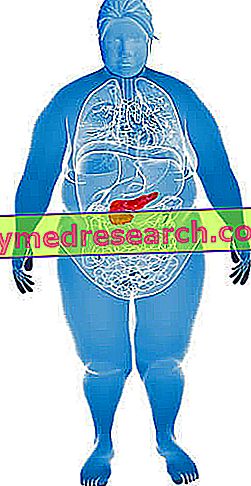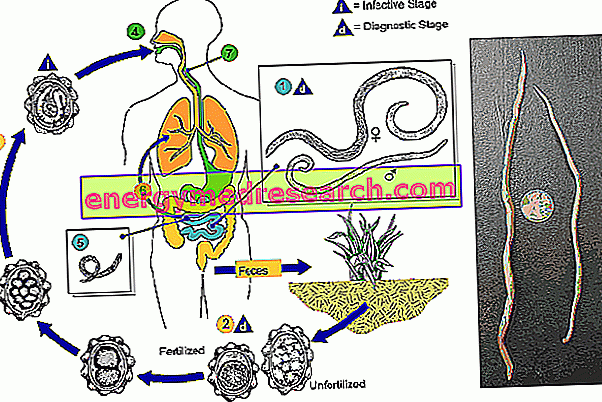The so-called "pancreatitis diet" is a food strategy that, if necessary, promotes the cure of the disease and opposes the worsening of general health.
Pancreas, Pancreatitis and Diet
What is Pancreatitis?
Pancreatitis is an inflammatory disease that affects the pancreas.

By negatively affecting these functions of the pancreas, pancreatitis worsens food digestion and the metabolism of some nutrients; this explains the need to adopt a specially calibrated diet.
Causes and Consequences
The triggering causes of pancreatitis can be very varied, but they are all characterized by a kind of " self-digestion " of the gland which, depending on the point where it remains damaged, loses its typical secretive capacity.
When the pancreas is affected by an inflammatory process, the cells are damaged and its digestive enzymes come into contact with the surrounding tissues, degrading them to cause bleeding, infections, etc. in the event that these digestive juices enter the bloodstream, even very distant organs such as the kidneys and the heart may remain involved.
Purpose of the Pancreatitis Diet
It is therefore quite logical to think that the pancreatitis diet is essential to improve health and a better prognosis.
These nutritional regimens are not aimed at removing the causative agent of the disease but, on the other hand, they are very important for the restoration / maintenance of the nutritional condition, without which the organism is hardly able to overcome a critical situation.
The diet for acute pancreatitis and the chronic nutritional regime are quite different.
After having clarified the differences between the two clinical pictures, we will analyze in more detail the guidelines to follow.
Types of Pancreatitis
Pancreatitis is classified into two categories:
- Acute pancreatitis : sudden onset and high danger of death; the most frequent causes are: pharmacological, traumatic, for alcohol abuse and for gallstones (in the case where it obstructs the common bile duct); more rarely, infectious or poisonous.
The main symptom of acute pancreatitis is pain (localized or irradiated) but nausea, vomiting, fever and increased heart rate also appear. The diagnosis must take into consideration the presence of pancreatic enzymes in the blood, the increase of certain electrolytes and glucose.
Therapy (if necessary) is aimed at removing the causative agent. The maintenance of vital parameters and the compensation of complications are of great importance; sometimes, surgery is necessary (removal of cysts, stones, necrotic tissue, etc.). Mortality is estimated at 15%.
- Chronic Pancreatitis : it has an aetiology frequently related to: alcohol abuse (70% of cases), autoimmunity, use of certain drugs and familiarity.
It occurs mainly following a failure or partial resolution of acute pancreatitis. In the long term, serious complications can arise such as: hardly reversible weight loss, diabetes mellitus and digestive disorders.
The immediate symptom is pain (localized or irradiated); later, clinical signs may appear that correspond to the complications themselves, or nutritional malabsorption of various kinds (including weight loss) and, at an advanced stage, diabetes mellitus (which is also one of the most important complications).
Diagnosis can be made using systems such as blood analysis, ultrasound, computerized tomography, etc.
The treatment is aimed at the moderation of pain and the maintenance of nutritional parameters, which is why a specific diet associated with the intake of drugs containing pancreatic enzymes becomes fundamental.
Mortality is lower than in the acute phase and seems mainly related to complications associated with certain comorbidities.
Acute Pancreatitis Diet
The diet for acute pancreatitis varies greatly depending on the severity of the disease.
In the more serious forms it is better to avoid any form of oral feeding, both food-based and based on parenteral solutions (gastric nose tube).
This is absolutely necessary to keep the organ at rest, which in most cases is not able to adequately perform either its endocrine function or its exocrine function.
Nutrition for severe acute pancreatitis takes place predominantly intravenously and is often associated with drugs such as analgesic, antibiotic, hormonal (insulin) etc.
The requirements of parenteral nutrition for severe acute pancreatitis are:
- High water content
- Concentration of carbohydrates proportional to blood sugar
- Low lipid content, mainly composed of medium chain fatty acids
- Medium portion of essential amino acids
- Salts and vitamins in normal quantities.
In the milder forms, however, when the resolution is estimated approximately in 24 or 48 hours, it is possible to renounce intravenous nutritional administration limited to water compensation; in some cases, it is possible to start the food-based diet early.
For both situations, from the moment the levels of pancreatic enzymes fall into the ordinary, it is possible to start with a solid diet.
The basic requirements of this diet are:
- TOTAL elimination of alcohol (including wine with meals) and beverages with other nerves (coffee, tea, energy, etc.)
- High total energy fractionation, with at least 6 small meals
- High water content
- High carbohydrate content, especially with a low glycemic-insulin index
- Low concentration of high glycemic-insulin index glucides (especially in the case of diabetes mellitus)
- Low lipid content
- Modest protein content of animal origin, to be progressively increased.
Chronic Pancreatitis Diet
Chronic pancreatitis is characterized by a state of chronic (more or less severe) malabsorption, sometimes associated with dyspepsia and pain (which may increase with meals); this often causes the denial of food by the sick.
The goals of the pancreatitis diet are to combat malnutrition due to malabsorption and to stimulate pancreatic activity to a minimum.
The basic requirements of this diet are:
- TOTAL elimination of alcohol (including wine with meals) and beverages with other nerves (coffee, tea, energy, etc.)
- High total energy fractionation, with at least 6 small meals
- High water content
- Normal concentration of carbohydrates, preferably with a low glycemic-insulin index; about 60% of the total energy
- Normal protein concentration; about 15% of the total energy or 0.8g per kg of desirable physiological weight
- Minimum lipid concentration; about 25% of the total energy
- Amount of fibers equal to or less than 15-20g / day.
It is desirable, especially in cases of more pronounced malabsorption, to use vitamin supplements. This intervention is necessary due to the poor digestive potential, in particular of the liposoluble molecules (moreover, taken in limited quantities to avoid pancreas fatigue).
Sometimes, doctors choose to administer drugs containing pancreatic enzymes to compensate for the functional deficit.
The main sources of carbohydrates with a low glycemic-insulin index must be hulled legumes and refined grains, preferably in soupy recipes. This recommendation, which does not seem to respect the need to moderate the glycemic-insulin index, is essential to prevent the fibers from excessively hindering the action of enzymes (both endogenous and exogenous).
Proteins with a high biological value should be taken by combining legumes and cereals, and by lean foods of animal origin such as chicken and turkey without skin, lean cuts of veal - beef, pork loin, sea bream, sea bass, cod, plaice, egg whites, flakes of low-fat cheese (better to avoid other cheeses) etc.
The cooking of all foods must be totally free of added fats, which is why it is suggested to use non-stick pans or to practice techniques such as: boiling, steaming, pressing, bain-marie, jar and vacuum.
In the diet for chronic pancreatitis, condiments should be based on oils rich in medium chain fatty acids, whose absorption is independent of the action of bile and pancreatic lipases; in principle, it is better not to exceed 30-40g / day.
The oil that boasts the highest quantity of medium chain fatty acids is coconut oil; also the butter boasts a good percentage, but it is not advisable because of the saturated nature of the fatty acids that compose it.



